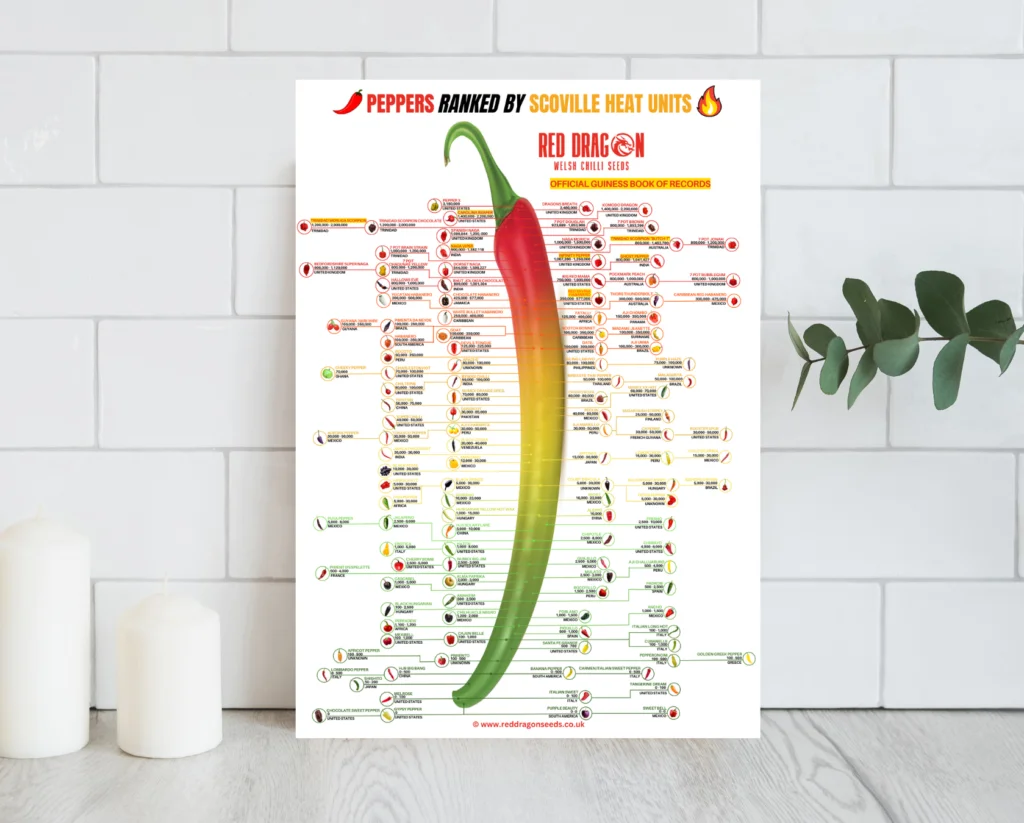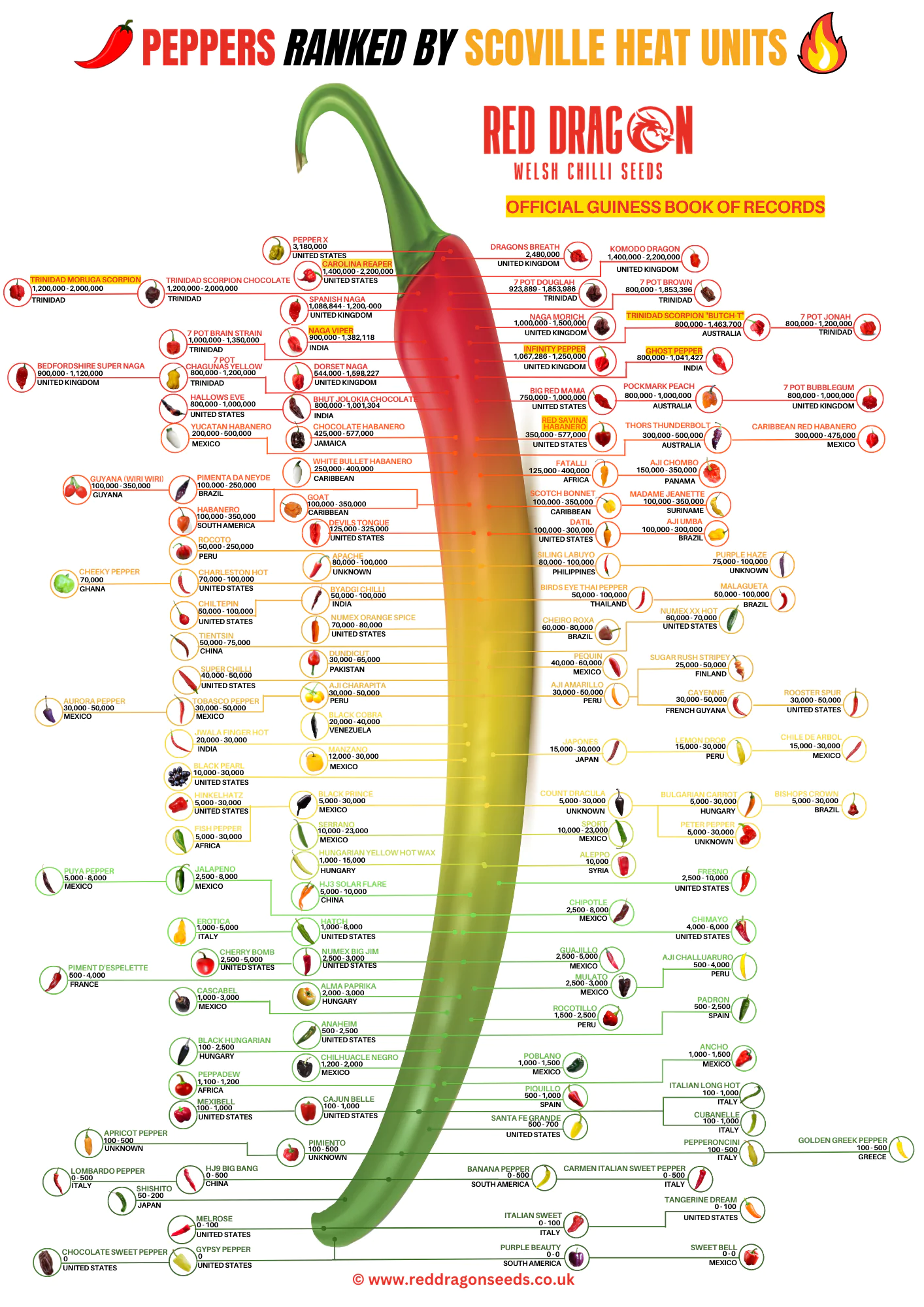Here is a handy chart that we created that lists most of the popular chilli peppers by the Scoville Heat Unit (SHU)

Scoville Chart Poster – A2 Laminated Scoville Chart with over 120 Chilli Types Listed
[DISPLAY_ULTIMATE_SOCIAL_ICONS]

Share this Image On Your Site – Use Embed Code Below.
<p><strong>Please include attribution to www.reddragonseeds.co.uk with this graphic.</strong><br /><br /><a href=’https://www.reddragonseeds.co.uk/scoville-heat-units-pepper-chart/’><img src=’https://reddragonseeds.co.uk/wp-content/uploads/2022/07/Scoville-Heat-Units-Pepper-Chart.jpg‘ alt=’Scoville Heat Units Pepper Chart’ width=’800′ /></a></p>
[DISPLAY_ULTIMATE_SOCIAL_ICONS]
Scoville Heat Units
- 0-100 Scoville Units includes most Bell & Sweet pepper varieties.
- 500-1000 Scoville Units includes New Mexican peppers.
- 1,000-1,500 Scoville Units includes Espanola peppers.
- 1,000-2,000 Scoville Units includes Ancho & Pasilla peppers.
- 1,000-2,500 Scoville Units includes Cascabel & Cherry peppers.
- 2,500-5,000 Scoville Units includes Jalapeno & Mirasol peppers.
- 5,000-15,000 Scoville Units includes Serrano peppers.
- 15,000-30,000 Scoville Units includes de Arbol peppers.
- 30,000-50,000 Scoville Units includes Cayenne & Tabasco peppers.
- 50,000-100,000 Scoville Units includes Chiltepin peppers
- 100,000-350,000 Scoville Units includes Scotch Bonnet & Thai peppers.
- 200,000 to 300,000 Scoville Units includes Habanero peppers.
- 300,000 to 600,000 Scoville Units includes Fatalii, Red Savina and Devils Tongue
- 600,000 to 1,000,000 Scoville Units includes Bhut Jolokia, Hallows Eve, 7 Pot
- 1,000,000 to 1,500,000 Scoville Units includes Trinidad Scorpion Butch T, Naga Viper, 7 Pot Primo
- 1,000,000 to 2,500,000 Scoville Units includes Trinidad Moruga Scorpion, 7 Pot Douglah and the World Record Holder the Carolina Reaper
- 16,000,000+ Scoville Units is Pure Capsaicin.
The heat of chile peppers is measured in Scoville Heat Units. Bell peppers rank at zero SHU’s, Jalapeños at 3,000–6,000 SHU’s and Habaneros at 300,000 SHU’s. The record for the highest number of SHU’s in a pepper is assigned by the Guinness Book of Records, to the Red Savina Habanero, with 577,000 SHU’s.
Pure capsaicin rates at 16,000,000 SHU’s.
A US manufacturer of hot sauces has made what he claims is the most pungent chilli powder it is possible to make. The powder is so hot that Blair Lazar’s customers have to sign a legal waiver before tasting it. The pure Capsaicin, 30 times hotter than the hottest pepper and 8,000 times hotter than Tabasco sauce, is distilled from several tons of fresh peppers. Capsaicin does not actually burn, instead it stimulates nerve endings in your mouth, giving the sensation of burning. Over the past decade or so, manufacturers have taken the humble chilli pepper and distilled it into ever more fiery sauces. The names of the concoctions, After Death Sauce and Insanity Sauce are just two, give some idea of the pain that is involved during and after consuming them.
Chile peppers are the fruit of the plant Capsicum that forms part of the nightshade family (Solanaceae).
History
As early as 7000 BC native Indians in the New World were eating the wild “chiltecpin” (piquín) pepper. This is a small and very pungent chile eaten like peanuts today only by the brave. It is believed that chile peppers were domesticated between 5200 and 3400 B.C. by nomadic Indians dependent on the harvesting of wild plants for more than half of their food. Chile peppers were first cultivated in South America around 2300 BC by the Incas who called them “Uchu” in the Quechua language and “Huayca” in the Aymara language. The Incas worshipped the chile pepper as one of the holy plants and used it to represent the teachings of the early kings.
Before 1500 B.C. chiles travelled north into Mexico and gained the reputation as a spicy condiment, becoming an important part of the native diet. Around this time the Olmecs, one of the first agricultural tribes, settled in what is now Veracruz in Mexico.
At about 500 B.C. the Monte Alban culture of the Zapotec Indians from the valley of Oaxaca, Mexico, began exporting to neighbouring tribes the “Suchilquitongo” bowls that resemble the handheld mortars or molcajetes. These bowls are believed to be the first evidence that people crushed chiles for chile powder. When the Mayas reached the peak of their civilization about 500 A.D. in southern Mexico and the Yucatan Peninsula. They were growing many different varieties of chiles, an important ingredient in the Mayan diet. They used chiles in almost every meal, from breakfast, which was a hot cereal of ground maize spiced with chile peppers called atole or pozol, to the evening meal of various stews spiced with chiles.
The Aztec were the last agricultural tribe to arrive in the area of Mexico City around 1200 A.D. The marketplaces of the Aztec overflowed with chiles of all shapes and sizes and many colours. They called this pungent fruit “chillis” in the Nahuatl language, which referred to both the red and green chile peppers.
Diego Alvarez Chanca, a physician on Columbus’ second voyage to the West Indies in 1493, brought the first chile peppers back to Spain, and was the first to write about their medicinal effects in 1494.

Great Chart!
How hot is 10-15,000 in reality – is that quite spicy or would that still be almost undetectable like a Jalapeno? I have just planted some F1 Longhorn 🌶 hoping to be able to put them whole on top of a pork chop or chicken leg when I bake them, or to chop them up and sprinkle on a burger patty to make a chilli-burger.
Also, at what point in time after they go completely red on the plant do they reach their full spiciness potential?